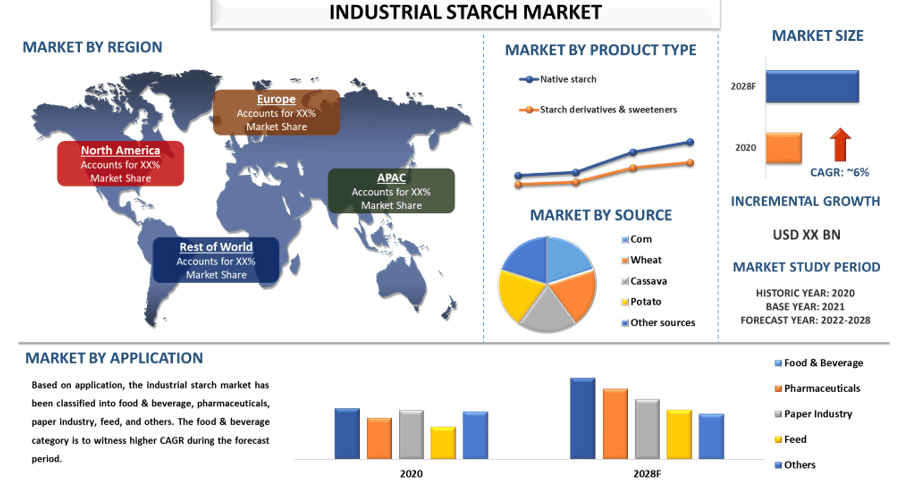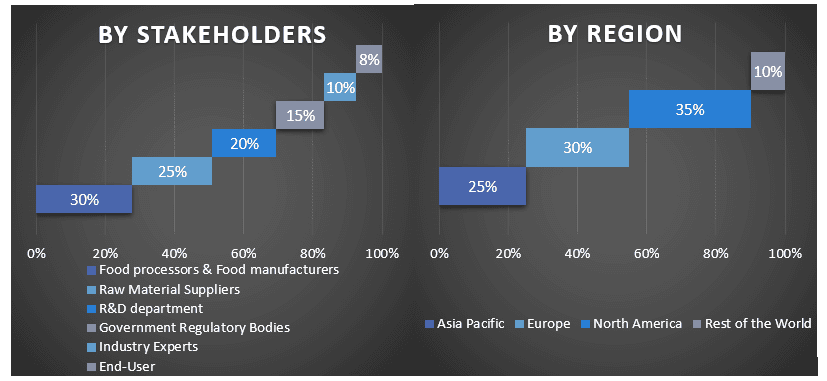- Home
- About Us
- Industry
- Services
- Reading
- Contact Us
Industrial Starch Market: Current Analysis and Forecast (2021-2027)
Emphasis on Product Type (Native starch, Starch derivatives & sweeteners); Source (Corn, Wheat, Cassava, Potato, Other sources); Application (Food & Beverage, Pharmaceuticals, Paper Industry, Feed, Others); and Region/Country

The Global Industrial Starch Market is expected to witness a CAGR of around 6% during the forecast period (2022–2028). To the growing demand for ready-to-eat food and multifunctional applications of starch, starch derivatives, and a diverse range of end-use industries. Major companies in the market offer industrial starch for food & beverage applications with technologically advanced features. For instance, in January 2021, Tate & Lyle expands its portfolio of tapioca-based thickening and gelling starches. The expansion includes the launch of new REZISTA® MAX thickening starches and BRIOGEL® gelling starches.
In addition, major players such as Cargill Incorporated, Archer-Daniels-Midland Company, Tate & Lyle PLC, AGRANA Beteiligungs-AG, Grain Processing Corporation, Roquette Frères, Royal Cosun, Eiamheng Tapioca Starch Industry Co. Ltd., General Starch Limited, The Kraft Heinz Company. Several M&As along with partnerships have been undertaken by these players to develop the industrial starch market.
Industrial starch is derived from various natural sources such as wheat, corn, cassava, potato, and other sources. As they are believed to be the most common carbohydrate found in human diets. Due to its multiple applications such as viscosifiers, emulsifiers, defoaming agents, encapsulation, and sizing agents. It is used in many industries such as pharmaceuticals, food & beverage industries, and others. In addition, industrial starch is extensively used in the paper industry during the manufacturing and coating process. Furthermore, starches are valued for their ability to impart textural characteristics and provide gelling or film formation.
Cargill Incorporated, Archer-Daniels-Midland Company, Tate & Lyle PLC, AGRANA Beteiligungs-AG, Grain Processing Corporation, Roquette Frères, Royal Cosun, Eiamheng Tapioca Starch Industry Co. Ltd., General Starch Limited, The Kraft Heinz Company. Several M&As along with partnerships have been undertaken by these players to develop the Industrial Starch market.
Insights Presented in the Report
“Amongst product type, native starch category to hold a significant share in the market”
Based on product type, the market is segmented into native starch and starch derivatives & sweeteners. Native starch category to witness higher CAGR during the forecast period as it is the original form of starch. It is commonly used in the formulation of food, pharmaceuticals, and other industrial products. In addition, the properties of native starch can be modified by acid and other chemical treatments at specific temperatures for different uses.
“Amongst source, corn segment is expected to dominate the market during the forecasted period”
On the basis of source, the market is categorized into corn, wheat, cassava, potato, and others. Among these, corn is expected to hold a significant share in the market. This is mainly due to the high demand for its textural properties as a thickening agent, especially in industries such as dairy and beverages. Additionally, corn starch is a carbohydrate derived from the endosperm of corn seeds. Corn starch is gaining importance in the market because it is gluten-free. Hence, it is an excellent source of energy and prevents hypoglycemia in people with nocturnal hypoglycemia.
“Amongst application, food & beverage to hold a significant share in the market”
Based on application, the industrial starch market has been classified into food & beverage, pharmaceuticals, paper industry, feed, and others. The food & beverage category is to witness higher CAGR during the forecast period. As the increased use of industrial starch in the bakery and confectionery sector is majorly seen during the last few years. Also, the growing demand for on-the-go groceries and various beverages from the coming generation and working population is expected to drive the market.
North America to witness significant growth during the forecast period”
North America is anticipated to grow at a substantial CAGR during the forecast period. This is because it is a highly developed whole food industry. For instance, the United States is the top producer of corn with 383.94 million tonnes from 2021 to 2022, which is used in a variety of application areas, including the production of starch. Additionally, the region is heavily skewed toward consuming gluten-free foods with the support of governments with strict regulations on product labeling of gluten-free ingredients. Most US processed food starches from which they are derived are gluten-free. Furthermore, the Canadian industrial starch market is growing rapidly due to increasing consumer demand for healthier and cleaner ingredients. The demand for native starch in this country is primarily driven by light applications with subtle flavors. Hence, the local manufacturers use it in processed foods to maintain the quality of their products which is driving the market growth of industrial starch in the region.
Reasons to buy this report:
- The study includes market sizing and forecasting analysis validated by authenticated key industry experts.
- The report presents a quick review of overall industry performance at one glance.
- The report covers an in-depth analysis of prominent industry peers with a primary focus on key business financials, product portfolios, expansion strategies, and recent developments.
- Detailed examination of drivers, restraints, key trends, and opportunities prevailing in the industry.
- The study comprehensively covers the market across different segments.
- Deep dive regional level analysis of the industry.
Customization Options:
The Global Industrial Starch Market can further be customized as per the requirement or any other market segment. Besides this, UMI understands that you may have your own business needs, hence feel free to connect with us to get a report that completely suits your requirements.
Table of Content
Research Methodology for the Global Industrial Starch Market Analysis (2022-2028)
Analyzing the historical market, estimating the current market, and forecasting the future market of the global industrial starch market were the three major steps undertaken to create and analyze the adoption of industrial starch in major regions globally. Exhaustive secondary research was conducted to collect the historical market numbers and estimate the current market size. Secondly, to validate these insights, numerous findings and assumptions were taken into consideration. Moreover, exhaustive primary interviews were also conducted, with industry experts across the value chain of the global industrial starch market. Post assumption and validation of market numbers through primary interviews, we employed a top-down/bottom-up approach to forecasting the complete market size. Thereafter, market breakdown and data triangulation methods were adopted to estimate and analyze the market size of segments and sub-segments of the industry pertains to. Detailed methodology is explained below:
Analysis of Historical Market Size
Step 1: In-Depth Study of Secondary Sources:
Detail secondary study was conducted to obtain the historical market size of the industrial starch market through company internal sources such as annual reports & financial statements, performance presentations, press releases, etc., and external sources including journals, news & articles, government publications, competitor publications, sector reports, third-party database, and other credible publications.
Step 2: Market Segmentation:
After obtaining the historical market size of the industrial starch market, we conducted a detailed secondary analysis to gather historical market insights and share for different segments & sub-segments for major regions. Major segments included in the report as product type, source, and application. Further country-level analyses were conducted to evaluate the overall adoption of testing models in that region.
Step 3: Factor Analysis:
After acquiring the historical market size of different segments and sub-segments, we conducted a detailed factor analysis to estimate the current market size of the industrial starch market. Further, we conducted factor analysis using dependent and independent variables such as various product types, sources, and applications of industrial starch equipment. A thorough analysis was conducted for demand and supply-side scenarios considering top partnerships, mergers and acquisitions, business expansion, and product launches in the industrial starch market sector across the globe.
Current Market Size Estimate & Forecast
Current Market Sizing: Based on actionable insights from the above 3 steps, we arrived at the current market size, key players in the global industrial starch market, and market shares of the segments. All the required percentage shares split, and market breakdowns were determined using the above-mentioned secondary approach and were verified through primary interviews.
Estimation & Forecasting: For market estimation and forecast, weights were assigned to different factors including drivers & trends, restraints, and opportunities available for the stakeholders. After analyzing these factors, relevant forecasting techniques i.e., top-down/bottom-up approach were applied to arrive at the market forecast for 2028 for different segments and sub-segments across the major markets globally. The research methodology adopted to estimate the market size encompasses:
- The industry’s market size, in terms of revenue (USD) and the adoption rate of the industrial starch market across the major markets domestically
- All percentage shares, splits, and breakdowns of market segments and sub-segments
- Key players in the global industrial starch market in terms of solutions offered. Also, the growth strategies adopted by these players to compete in the fast-growing market
Market Size and Share Validation
Primary Research: In-depth interviews were conducted with the Key Opinion Leaders (KOLs) including Top Level Executives (CXO/VPs, Sales Head, Marketing Head, Operational Head, Regional Head, Country Head, etc.) across major regions. Primary research findings were then summarized, and statistical analysis was performed to prove the stated hypothesis. Inputs from primary research were consolidated with secondary findings, hence turning information into actionable insights.
Split of Primary Participants in Different Regions

Market Engineering
The data triangulation technique was employed to complete the overall market estimation and to arrive at a precise statistical number for each segment and sub-segment of the global industrial starch market. Data was split into several segments & sub-segments post studying various parameters and trends in the areas of various product types, sources, and applications in the global Industrial Starch market.
The main objective of the global Industrial Starch Market Study
The current & future market trends other than the global Industrial Starch market were pinpointed in the study. Investors can gain strategic insights to base their discretion for investment on the qualitative and quantitative analysis performed in the study. Current and future market trends determined the overall attractiveness of the market at a regional level, providing a platform for the industrial participant to exploit the untapped market to benefit from a first-mover advantage. Other quantitative goals of the studies include:
- Analyze the current and forecast market size of the industrial starch market in terms of value (USD). Also, analyze the current and forecast market size of different segments and sub-segments
- Segments in the study include areas of product type, source, application
- Define and analysis of the regulatory framework for the industrial starch market industry.
- Analyze the value chain involved with the presence of various intermediaries, along with analyzing customer and competitor behaviors of the industry
- Analyze the current and forecast market size of the industrial starch market for the major region
- Major countries of regions studied in the report include Asia Pacific, Europe, North America, and the Rest of the world
- Company profiles of the industrial starch market and the growth strategies adopted by the market players to sustain in the fast-growing market
- Deep dive regional level analysis of the industry
Related Reports
Customers who bought this item also bought










